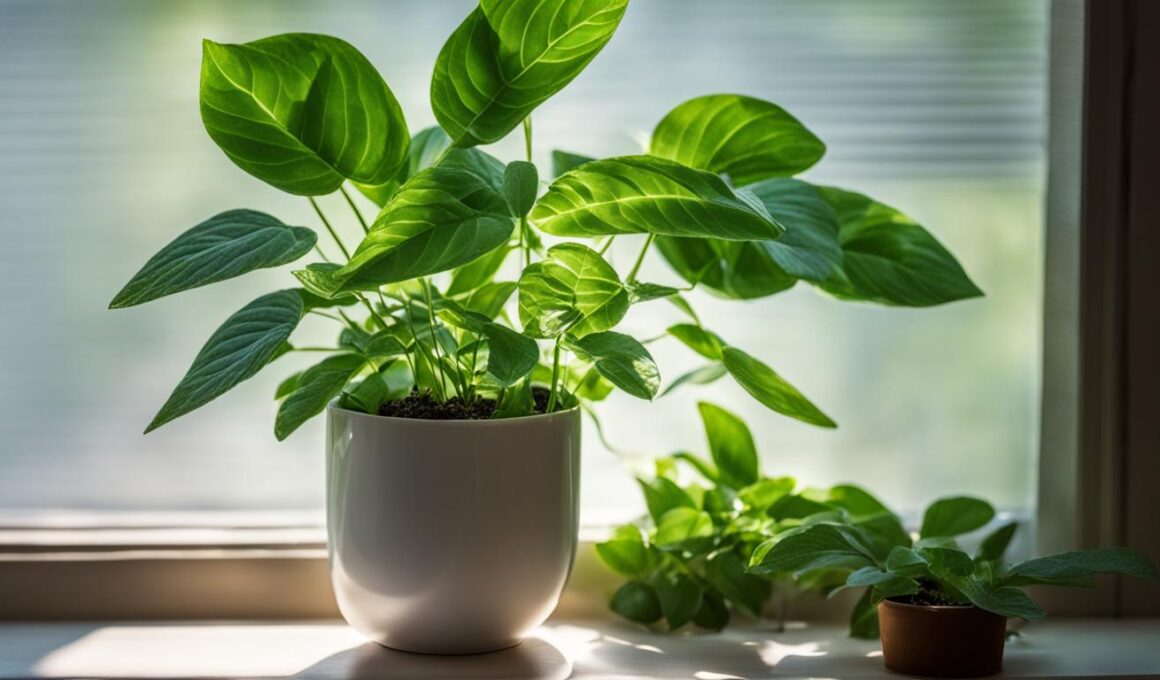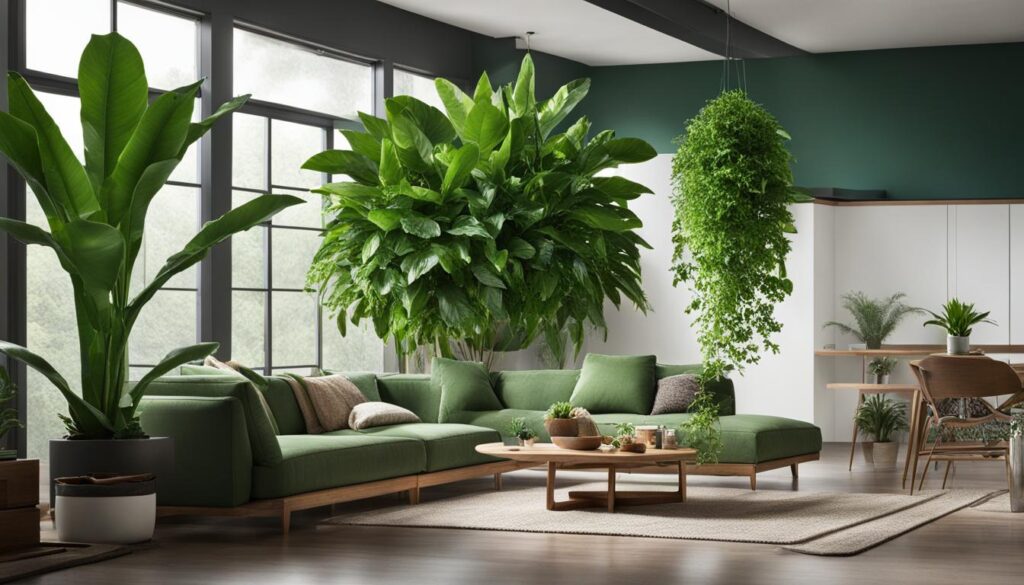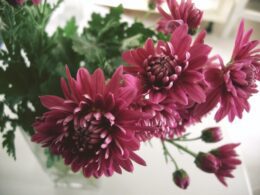Houseplants not only add beauty to your home but can also act as natural bug repellents. By strategically incorporating certain indoor plants into your living space, you can create a pest-free environment without resorting to harmful chemicals. Let’s explore the top indoor plants that are known for their bug-repelling properties.
Key Takeaways:
- Indoor plants can act as natural bug repellents, creating a pest-free home.
- Strategically incorporating bug-repelling plants into your living space can help deter pests without harmful chemicals.
- Basil, mint, sage, rosemary, citronella plant, lemongrass, marigolds, lavender, catnip, chrysanthemums, and carnivorous plants are effective bug deterrents.
- Common pests like mosquitoes, fruit flies, gnats, flies, cockroaches, fleas, and bedbugs can be deterred by certain indoor plants.
- Physical bug prevention methods, such as sticky traps, soil toppers, and physical barriers, can further protect your indoor plants.
8 Houseplants That Deter Bugs & Pests
When it comes to keeping your home bug-free, incorporating certain houseplants can be an effective natural solution. These plants not only add beauty to your indoor space but also have bug-repelling properties that can help create a pest-free environment. Here are 8 houseplants known for their ability to deter bugs and pests:
- Basil and Mint: These aromatic herbs emit a smell that insects find repulsive, making them great natural bug deterrents.
- Sage and Rosemary: Burning sage and rosemary creates a natural bug-repelling smoke that can keep pests at bay.
- Citronella Plant and Lemongrass: With their strong citrus scent, these plants are particularly effective against mosquitoes.
- Marigolds: The distinctive smell of marigolds repels flies, gnats, and mosquitoes.
- Lavender: Lavender produces an oil that deters various types of insects, including fleas, moths, and flies.
- Catnip: Not only loved by cats, catnip can repel mosquitoes and cockroaches.
- Chrysanthemums: These beautiful flowers are known to discourage ants, lice, fleas, bed bugs, silverfish, and even cockroaches.
- Carnivorous Plants: Unique and fascinating, carnivorous plants like the Venus’ flytrap can actually lure and trap bugs, offering a natural and effective way to control pests.
With these houseplants strategically placed throughout your home, you can create a bug-free environment while adding greenery and beauty to your living space. Incorporate a variety of these plants to maximize their bug-repelling potential and enjoy a pest-free home.
Benefits of Bug-Repelling Houseplants
Having bug-repelling houseplants in your home not only helps to keep pests away but also offers several additional benefits:
- Elimination or reduction of the need for harmful chemicals and pesticides.
- A more natural and eco-friendly approach to pest control.
- A fresher and cleaner indoor air quality, as many houseplants are known for their air-purifying abilities.
- Enhanced well-being and reduced stress levels, as interacting with nature and greenery has been shown to have positive effects on mental health.
- Improved sleep quality, as some houseplants, like lavender, can have calming and relaxing properties.
By incorporating bug-repelling houseplants into your home, you not only create a bug-free environment but also reap these additional benefits, making your living space healthier, more enjoyable, and closer to nature.
5 Common Pests That Houseplants Can Help Deter
Houseplants can be your allies in the battle against pests that commonly invade homes. By strategically incorporating certain plants into your indoor space, you can create a pest-free environment and protect your home and family. Let’s explore the top five pests that houseplants can help deter:
Mosquitoes
Mosquitoes are not only annoying but can also transmit diseases. Luckily, there are several plants that mosquitoes dislike. Citronella, lemongrass, basil, mint, sage, rosemary, marigolds, lavender, and catnip are all known to repel these blood-sucking pests.
Fruit Flies and Gnats
If you’ve ever dealt with fruit flies or gnats buzzing around your kitchen, you know how frustrating they can be. Many of the plants mentioned earlier, such as basil, mint, sage, rosemary, marigolds, lavender, and catnip, can also deter these tiny pests.
Flies
Flies can be a nuisance, especially during the warmer months. To keep them at bay, consider incorporating lavender, marigolds, Venus’ flytraps, or fragrant herbs like basil and mint into your living space.
Cockroaches
Cockroaches are unwelcome guests in any home. To discourage them from invading your space, try using chrysanthemums, catnip, peppermint, or lavender. These plants emit scents that cockroaches find repulsive.
Fleas and Bedbugs
Fleas and bedbugs can cause itchy bites and infest your home. To keep them at bay, consider using plants like lemongrass, lavender, citronella, catnip, and chrysanthemums. These plants are known to repel these pesky insects.
By strategically placing these houseplants throughout your home, you can create a natural defense against these common pests. Not only will your living space be more aesthetically pleasing with the addition of these plants, but you’ll also enjoy a bug-free environment without relying on harmful chemicals. Experiment with different plants and find what works best for your home to maintain a pest-free haven for you and your loved ones.
Physical Bug Prevention
In addition to using bug-repellent houseplants, there are other physical methods you can employ to prevent bugs from infesting your indoor plants.
One effective method is the use of sticky traps. These traps can be placed near your plants to catch flying pests like fungus gnats and whiteflies. The sticky surface of the traps acts as a magnet for the insects, preventing them from reaching your plants and reproducing. It’s a simple yet effective way to control the population of these pesky bugs.
Another physical prevention technique is the use of soil toppers. By adding a layer of sand or cinnamon to the top layer of soil, you create a barrier that deters bugs from laying their eggs or building nests in the soil. The texture and scent of these materials are unpleasant to insects, making your plants less inviting to them.
Lastly, physical barriers can be implemented to confuse and deter bugs. You can move your plants to different locations periodically to disrupt the insects’ navigation. Elevating your plants on plant stands can also make it more difficult for bugs to access them, providing an extra layer of protection. These physical barriers can be simple yet effective in keeping bugs away from your indoor plants.
The Benefits of Physical Bug Prevention:
- Sticky traps catch flying pests like fungus gnats and whiteflies.
- Soil toppers create a barrier that deters bugs from laying eggs or building nests.
- Physical barriers confuse and deter bugs from reaching your plants.
DIY Bug Sprays
If you prefer a more hands-on approach to keeping pests at bay, you can create your own bug sprays using natural ingredients. These DIY solutions are not only effective but also safe for your family and pets. Here are a few recipes to try:
- Soap and Water: Dilute a small amount of liquid soap in water and spray it on your plants to deter pests like spider mites, mealybugs, and aphids.
- Essential Oils: Mix water with essential oils such as orange, mint, clove, or lavender to create a fragrant bug repellent. Keep in mind that essential oils may not eliminate existing infestations but can help prevent future ones.
- Non-Essential Oils: Garlic, onion, and cottonseed oil can also be effective at repelling insects. Combine these oils with water and spray the mixture on your plants.
- Neem Oil: For a more potent option, use neem oil to repel spiders, ants, and certain flying bugs. Dilute the neem oil with water and spray it on your plants.
- Mad Scientist Solution: If you want an all-in-one bug spray, combine vinegar, neem oil, cottonseed oil, lavender oil, mint oil, and garlic oil. This concoction will help keep a wide variety of pests away from your plants.
Experiment with these DIY bug sprays to find the ones that work best for your specific pest problems. Remember to always test a small area of your plant before applying the spray to the entire plant, as some plants may be more sensitive to certain ingredients. Happy bug-repelling!
Conclusion
Keeping your home pest-free naturally is not only good for the environment but also safer for your family and pets. By incorporating bug-repellent houseplants, using physical bug prevention methods, and creating DIY bug sprays, you can maintain a pest-free haven without relying on harmful chemicals. Experiment with different plants and techniques to find what works best for your home and enjoy the benefits of a bug-free living space.
Can Homemade Bug Repellent for Gardens Also Work for Indoor Plants?
Yes, homemade bug repellent gardens can also work for indoor plants. Ingredients like neem oil, garlic, and essential oils like peppermint and lavender can effectively repel pests in both outdoor and indoor settings. Just be sure to test the spray on a small area of the plant to ensure it won’t harm it.
FAQ
Are there houseplants that can repel bugs and pests?
Yes, certain indoor plants have bug-repelling properties and can help keep your home pest-free.
What are some examples of houseplants that deter bugs?
Examples include basil, mint, sage, rosemary, citronella plant, lemongrass, marigolds, lavender, catnip, chrysanthemums, and carnivorous plants.
Which pests can be deterred by houseplants?
Houseplants can help deter mosquitoes, fruit flies and gnats, flies, cockroaches, fleas, and bedbugs.
What are some physical methods to prevent bugs from infesting indoor plants?
Sticky traps, soil toppers like sand or cinnamon, and physical barriers such as moving the plant or using an elevated stand can help prevent bugs from infesting indoor plants.
Can I create my own bug sprays with natural ingredients?
Yes, you can create DIY bug sprays using ingredients like soap and water, essential oils, non-essential oils, and neem oil.











